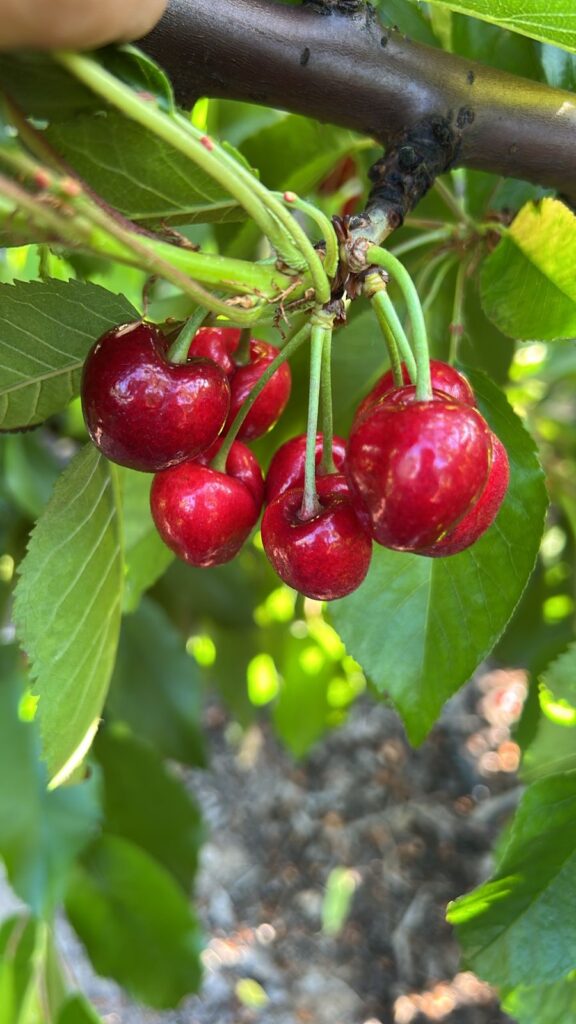Various weather sites have announced a mild frontal system for midweek that could leave just over 7mm of precipitation in the central part of the country; the rains could also return on Friday and remain until Sunday, but with less intensity.
Rain is almost always welcome in cherry orchards, especially with the mega-drought affecting much of the country, but spring precipitation can cause partial or complete loss of production.
When these types of weather phenomena occur close to ripening, accompanied by high temperatures, there is an increase in the internal pressure of the fruit, which can cause micro-fractures, subsequent cracking and even rotting. A similar scenario can occur with high ambient temperatures or drizzle. But why does this happen?
According to Carlos Tapia, Specialist Advisor in cherry production and Technical Director of Avium, and Héctor García, General Manager and Co-founder of Diagnofruit Laboratories in the article «Current analysis on the origin of cherry cracks and bases for their control»: «Rain cracking is the result of excessive net water absorption. This excess increases the turgor of the pulp, which then deforms and eventually breaks the fruit epidermis at the weakest point. This idea was adapted from a model hypothesized in grapes in the early 1970s, called the “critical turgor hypothesis,” and assumes that the fruit is composed of pulp in a semi-fluid state, which in turn is kept under pressure by an epidermis under constant tension.»
Specialists also point out that: «Several empirical and experimental observations support this hypothesis, including that the cherry has two tissues that respond to the model, pulp and a thick skin. In turn, there is no evidence that the pit or seed has any responsibility for the disorder; certainly the cherry skin is under tension and it is also known that changes in irrigation can increase cracking. While the above observations are consistent with the critical turgor model, it is important not to lose sight of the fact that a recent publication reported low turgor pressure in mature cherries and, in particular, a lack of turgor response to water absorption and transpiration, all evidence that could make the postulated critical turgor model questionable.»
There are also other hypotheses, for example the "zipper" hypothesis, which takes the turgor hypothesis as a basis to explain why cherries split, but concludes that cracking would be a localized event. It is known as the zipper hypothesis and was coined in Germany by the research group of the Dr. Moritz Knoche (Institute of Horticultural Production Systems, University of Hannover).
This hypothesis is quite interesting, since the zipper model is consistent with the higher frequency of cracking in the pedicellar cavity and the region of the stylar scar (“crescent” split), compared to the cheek region or the suture. Tapia and García explain it well: «Microcracks result from a mismatch between the expansion of the surface area and the cuticular deposition, a similar situation is observed in table grapes when growth regulators are abused. These areas are subjected to prolonged periods of surface humidity after rain, water deposited in the cavity and “hanging” in the stylar zone«.
Tests on this have already been carried out and in fact in July 2020 the same researchers published an interesting studyThe test consisted of, for three seasons, subjecting to controlled precipitation fruit attached to the plant, fruits harvested and placed in Mini-cages in different positions of the tree and, furthermore, fruit immersion in deionized water.
«This formal experimental design allowed observing the behaviour of fruit with water flow from the plant (fruit attached to the tree) and without it (fruit in immersion and cages). The different treatments presented different results in terms of the appearance of cracking over time and also in relation to the amount of water absorbed to cause cracking. Thus, fruits attached to the tree split slowly and at a low frequency and also required more water to crack, in relation to the fruit in immersion; in addition, the cracks were more commonly found in the region of the pedicel cavity and were noticeably less common in the region of the stylar scar. When simulating rain falling on detached fruit hanging on trees (in cages), the cracking was even slower and required even more water to occur. The fruit in immersion absorbed more water than the fruit attached to the tree under a controlled precipitation regime and the latter absorbed more than the fruit in cages subjected to the same precipitation regime, probably due to the contribution of the phloem flow», Carlos Tapia and Héctor García explain in the aforementioned article.
After the test and the evidence it presented, clear conclusions were reached regarding why cherries split: «Analyzing all this behavior at the same time, it is discussed that the large moistened surface in the fruit in immersion It is the component that determines the high sensitivity to cracking, in the simulated rain experiment, regardless of whether it was attached to the tree or in a cage, only the 18% of the surface would be in constant humidity and said humidity is concentrated in the pedicellar cavity and stylar zone, hence the result of lower frequency of the problem. Next would be the phloem flow that contributes to the development of the crack, but with a very minor impact on the final result; in conclusion, everything described would be explained through the zipper hypothesis, where localized humidity would be responsible for the cracks in the field and the flow of water through the phloem from the plant would contribute, but in a very secondary way.", Tapia and García detailed regarding the recent study.
Can splitting be controlled?
The use of covers is undoubtedly the most effective. There is no method or management that ensures the protection provided by covers against rain. Their indiscriminate use, without the appropriate handling and materials, could influence the quality and condition of the fruit, but with handling in accordance with the proposed objectives, it can not only prevent damage from rain, but could also improve characteristics such as size and even, with new technologies in the use of plastics, advance phenological states.
Another possibility that offers good results is to remove water from the surface of the fruit immediately after rain, of course considering light and not very prolonged rainfall. There are two alternatives for this:
- Turbo-nebulizers without charge, to generate wind jets and/or helicopters using the countercurrent rotor.
Carlos Tapia, a specialist advisor in cherry production, and Héctor García, co-founder of Diagnofruit Laboratories, provided details on this matter: «Probably, the ease of having access to agricultural machinery in an orchard is exaggeratedly greater than having a helicopter, which is why the first alternative is the closest to our reality; however, in terms of efficiency, a tractor must move the machine at no more than 0.9 ms-1 For treatment to be effective and safe, manned helicopters can fly at speeds of 2.3–4.5 ms-1, significantly increasing the surface to be controlled in a race against time, before the process of opening our cellular “zippers” begins. Today there is the possibility of using unmanned helicopters, but they are still in development to improve performance«.
-Waxes and polymers: «It is likely that these types of products work, but it is up to us to ensure that they are effective, for this it is necessary to carry out successive and well-controlled applications to achieve the objective; the important thing is that the products are applied to the fruit in a homogeneous manner, therefore tests must be carried out in the target areas, pedicellar cavity and stylar area, which is where we must reduce the risk, since we know that prolonged exposure to water in these areas ends in a crack.", the specialists warned.
According to Tapia and García, the most commonly used techniques by producers to prevent cracking in Chile, all of which are complementary, include:
-Use of hydrophobic films (Biofilms): With products formulated especially for this work, research in Chile has shown good performance against rains that are not very intense or of long duration.
«Implemented as an application program from the beginning of painting, it has been possible to verify that up to 50% of the total number of cracks can be protected compared to a control treatment. However, after an event of very extensive rainfall, where the amount of precipitation falls into the background, the results are more uncertain and less consistent., they explained.
-Use of Ca Chloride (CaCl2): Before and during rain, this strategy allows rainwater to remain off the fruit for as long as possible due to the effect of osmotic balance.
«Constant and successive applications before and during rainfall at use concentrations of 0-5%-1% have been favourable when proper operation has been maintained. The operation is complicated because it requires a high use of machinery since it should be applied at maximum intervals of two hours in the same place while it is raining to avoid the washing effect of the precipitation.», Tapia and García point out.
-Drying: Ideally with helicopters and blowers, efficiently and just after the rain.
«The use of helicopters is expensive, but it has proven effective in removing water from trees, preventing splits, especially those that are located in the pedicellar area known as the crescent moon.»
It is extremely important that the orchard has received the proper application of fungicides at least 24 hours before a rainfall event. Tolerances should always be checked, considering the short time left until harvest.
It should be noted that sensitivity to rain begins from the straw-colored state/start of appearance, It is therefore necessary to pay attention to rainfall forecasts prior to and during this period, in order to implement strategies for each particular situation.










